 Cover of the English edition | |
| Author | Alexander Knox |
|---|---|
| Published | Toronto: Macmillan of Canada, 1971 |
Night of the White Bear is a novel of the Arctic by Canadian actor and novelist Alexander Knox, first published by Macmillan of Canada in 1971. [1]
 Cover of the English edition | |
| Author | Alexander Knox |
|---|---|
| Published | Toronto: Macmillan of Canada, 1971 |
Night of the White Bear is a novel of the Arctic by Canadian actor and novelist Alexander Knox, first published by Macmillan of Canada in 1971. [1]
The story follows Uglik, a young Eskimo, his journey of survival with two others in the Canadian Arctic, and his final confrontation with the lone polar bear which has stalked them. [1] [2] [3] [4]
Night of the White Bear was Knox's second work of fiction. [1] Contemporary reviewers noted the strong sexual and anthropological themes of the novel. [1] [2] [3]

Knud Johan Victor Rasmussen was a Greenlandic-Danish polar explorer and anthropologist. He has been called the "father of Eskimology" and was the first European to cross the Northwest Passage via dog sled. He remains well known in Greenland, Denmark and among Canadian Inuit.

Kaktovik is a city in North Slope Borough, Alaska, United States. The population was 283 at the 2020 census.
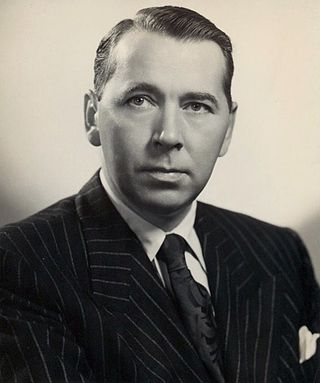
Alexander Knox was a Canadian actor and writer. He appeared in over 100 film, television, and theatrical productions over a career spanning from the 1920s until the late 1980s. He was nominated for an Oscar and won a Golden Globe for his performance as American President Woodrow Wilson in the 1944 film Wilson. However, his career in the United States was hampered by McCarthyism, and he spent the rest of his career in the United Kingdom.

Herschel Island is an island in the Beaufort Sea, which lies 5 km (3.1 mi) off the coast of Yukon in Canada, of which it is administratively a part. It is Yukon's only large offshore island.

Vilhjalmur Stefansson was an Arctic explorer and ethnologist. He was born in Manitoba, Canada.
White bear may refer to:
Robert Geoffrey Trease FRSL was a prolific British writer who published 113 books, mainly for children, between 1934 and 1997, starting with Bows Against the Barons and ending with Cloak for a Spy in 1997. His work has been translated into 20 languages. His grandfather was a historian, and was one of the main influences on his work. He is best known for the children's novel Cue for Treason (1940).

Fred Bruemmer, D.Litt. was a Latvian Canadian nature photographer and researcher. He spent his life travelling extensively throughout the circumpolar regions and to other remote parts of the globe. His works have been centered mostly on the Arctic, its people and its animals. He also conducted research and published on animals in many other areas of the globe. He spoke nine languages and wrote more than a thousand articles for publications around the world, including Canadian Geographic, Natural History, National Geographic and Smithsonian. Fred Bruemmer lived in Montreal, Quebec.
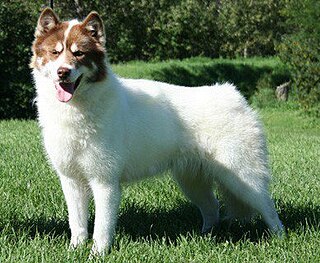
The Canadian Eskimo Dog or Canadian Inuit Dog is a breed of working dog from the Arctic. Other names include qimmiq or qimmit. The Greenland Dog is considered the same breed as the Canadian Eskimo Dog since they have not yet diverged enough genetically to be considered separate breeds, despite their geographic isolation.

James Archibald Houston was a Canadian artist, designer, children's author and filmmaker who played an important role in the recognition of Inuit art and introduced printmaking to the Inuit. The Inuit named him Saumik, which means "the left-handed one".

Eskimo is a 1933 American Pre-Code drama film directed by W. S. Van Dyke and released by Metro-Goldwyn-Mayer (MGM). It is based on the books Der Eskimo and Die Flucht ins weisse Land by Danish explorer and author Peter Freuchen. The film stars Ray Mala as Mala, Lulu Wong Wing as Mala's first wife Aba, Lotus Long as Mala's second wife Iva, Peter Freuchen as the Ship Captain, W. S. Van Dyke as Inspector White, and Joseph Sauers as Sergeant Hunt.

Inuit are a group of culturally and historically similar Indigenous peoples traditionally inhabiting the Arctic and subarctic regions of North America, including Greenland, Labrador, Quebec, Nunavut, the Northwest Territories, Yukon (traditionally), Alaska, and Chukotsky District of Chukotka Autonomous Okrug, Russia. Inuit languages are part of the Eskimo–Aleut languages, also known as Inuit-Yupik-Unangan, and also as Eskaleut. Inuit Sign Language is a critically endangered language isolate used in Nunavut.

Copper Inuit, also known as Inuinnait and Kitlinermiut, are a Canadian Inuit group who live north of the tree line, in what is now the Kitikmeot Region of Nunavut and in the Inuvialuit Settlement Region in the Inuvik Region of the Northwest Territories. Most of them historically lived in the area around Coronation Gulf, on Victoria Island, and southern Banks Island.
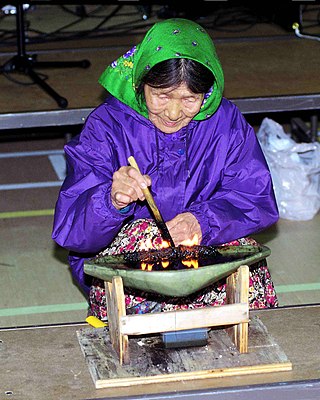
The Inuit are an indigenous people of the Arctic and subarctic regions of North America. The ancestors of the present-day Inuit are culturally related to Iñupiat, and Yupik, and the Aleut who live in the Aleutian Islands of Siberia and Alaska. The term culture of the Inuit, therefore, refers primarily to these areas; however, parallels to other Eskimo groups can also be drawn.
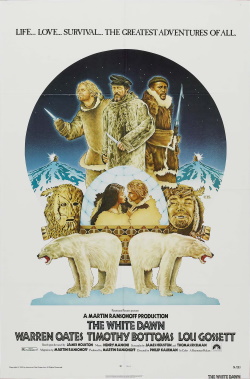
The White Dawn is a 1974 Canadian-American drama film directed by Philip Kaufman and starring Warren Oates, Timothy Bottoms, and Louis Gossett Jr. It portrays the conflict between aboriginal peoples' traditional way of life and Europeans' eagerness to take advantage of them. The film employs authentic Inuit language dialogue. It is based on the 1971 novel The White Dawn: An Eskimo Saga by James Archibald Houston, who co-wrote the screenplay.
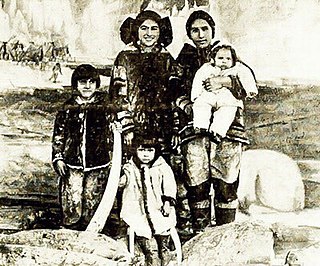
The Way of the Eskimo is a lost 1911 American silent drama film that portrayed the Inuit or "Eskimo" culture of northeastern Canada along the coast of Labrador. Directed by William V. Mong and produced by Selig Polyscope Company, this "photoplay" was based on a love story written by Columbia Eneutseak, a young Inuit woman who was born in the United States in 1893, in the "Esquimaux Village" exhibition at the World's Columbian Exposition in Chicago. She, fellow Inuit performer Zacharias Zad, and William Mong costarred in the film with a supporting cast that included members of Columbia's immediate family and other Inuit players. While this production was promoted in 1911 as being filmed on location in northern Canada, it was actually shot that year at the snow-covered port town of Escanaba, Michigan, along a frozen stretch of shoreline of Little Bay de Noc, which connects to Lake Michigan.

Lost in the Arctic is a lost 1911 American silent drama film that portrayed the Inuit or "Eskimo" culture in the northern coastal area of Labrador. Directed by William V. Mong and produced by the Selig Polyscope Company, the "one-reeler" costarred Columbia Eneutseak, J. C. Smith, and also Mong. The film was not, as advertised by Selig and in trade publications in 1911, shot in the Arctic or even farther south in Labrador. It and another Selig release, The Way of the Eskimo, were produced at the same time in the same location in the United States, in Escanaba, Michigan. Both "Arctic" stories were filmed there in less than two weeks during the early winter months of 1911, staged along the frozen shoreline of Little Bay de Noc that connects to Lake Michigan.
The Goose Wife is a mythical female character that appears in tales from the Inuit and other ethnic groups that dwell across the circumpolar Arctic region. The usual story is that the geese alight on land, become women by taking off their goose-skins and bathe in a lake. However, they are unaware that a human hunter is spying on them, and he steals the goose-skin of one of them, forcing her to be his wife. Due to the great similarities between both characters, the goose wife has been compared to the swan maiden, another female that alternates between human and bird forms.

Irene Baird was an English-Canadian novelist, journalist and civil servant. She is best known for her 1939 novel Waste Heritage, a depiction of labour strife. Baird wrote four novels and also contributed journalism, stories, and poetry. In the early 1940s she began work for National Film Board and then the government of Canada, eventually becoming the first woman to head a federal information division.

The Kidnapped Surgeon is a novel by Alexander Knox, published in 1977.